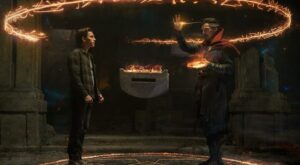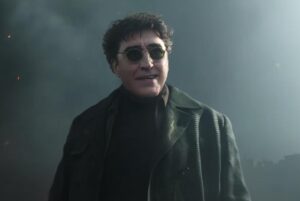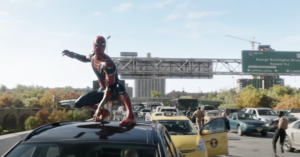There’s a certain irony to the fact that Tom Holland’s Spider-Man and his villains are so extensively intertwined with the rest of the Marvel Cinematic Universe that Spider-Man: No Way Home already feels more like a proper Spider-Man movie simply because Peter Parker is facing off against villains from pre-MCU Spider-Man movies, but hey, I’m not complaining…at least not about the villains that we’re actually getting in No Way Home. Yeah, it’s sad that the MCU hasn’t got their own versions of these iconic characters (yet), but I’m not sure I’d have trusted director Jon Watts with that great responsibility either.

The villains that Holland’s Spider-Man has fought up until this point, like Holland’s Spider-Man himself, have suffered from being weighed down by MCU baggage. To be fair, Vulture actually makes sense as a victim of Tony Stark’s ruthless pursuit of profit, but then Marvel undermined their own creativity by doing the same storyline again, only worse. Mysterio’s generic quest for vengeance against Stark did little to benefit a potentially interesting character.
And Stark is only one of several MCU characters who have loomed over the franchise, pulling focus from Holland and his actual supporting cast, most egregiously the underutilized Zendaya. Every Spider-Man movie features a big-name MCU hero in a major supporting role (Stark in Homecoming, Nick Fury in Far From Home, Doctor Strange in No Way Home) who invariably makes a mess that Peter Parker then has to spend the entire movie cleaning up. Fans often critique solo movies, like Doctor Strange or more recently Eternals, for feeling disconnected from the broader MCU, but MCU Spider-Man perfectly demonstrates the dangers of leaning too far in the opposite direction.
Shoehorning in all these connections has given Watts and his writers an excuse to stop fleshing out the characters they’re actually supposed to be building a franchise around, which is how we end up with only a vague idea of who Holland’s Peter Parker is, much less his circle of friends and family. I don’t know if No Way Home will actually remedy this issue, because it’s a sprawling Multiverse epic with a lot of characters and subplots, but at least this time around Tom Holland’s onscreen competition comes from other Spider-Men and their own villains.
We all know that Tobey Maguire and Andrew Garfield are in No Way Home at this point. Technically it’s still only a rumor and I still need to point that out, but this is not another case of Mephisto fever – hard evidence exists, and you can find it in this very trailer. Doc Ock even indirectly mentions Tobey Maguire’s Spider-Man when he confronts Tom Holland in what looks to be their first fight. We can see that Ock’s instantly iconic introductory line, “Hello, Peter”, is followed by confusion when Ock actually unmasks the MCU’s Spider-Man and is taken aback, saying “You’re not Peter Parker”. Who’s he referencing? Probably the same guy who’s very clearly punching Lizard in a frame from the Brazilian version of the trailer.
But Sony wants the Maguire and Garfield reveal to be a surprise for moviegoers, and I respect that. So for now, this trailer just focuses really heavily on all of their villains – okay, well, five of their villains; just enough to indicate that Marvel is assembling a Multiverse Sinister Six team, but one short of completion. Personally, I think that empty slot has to be filled by someone from Holland’s own universe. If the MCU really can’t come up with one Spider-Man villain of their own, that would be extremely embarrassing and very telling of how this franchise has been mishandled. My bet’s on Mysterio posing as Doctor Strange, because I still don’t get why Benedict Cumberbatch is acting so weird in these trailers, but Vulture would work.

Of the villains pulled from other universes, the stand-out to me is Jamie Foxx’s Electro – because my god, what an upgrade. Last time we saw his version of the iconic villain, he was inexplicably neon blue. Now, he’s wreathed in comics-accurate yellow lightning, and most importantly he’s wearing a proper costume and his starfish mask. Granted, the mask is made of CGI lightning, but it works better than I ever expected it to. Scratch that, I never expected them to adapt the mask in the first place, so this is a welcome surprise. Electro has been my favorite Spider-Man villain since as long as I’ve known about Spider-Man at all.
Doc Ock and Green Goblin both look pretty good in costumes lifted from the Sam Raimi films in which they originated, although there’s a clear difference between how Raimi directed both characters and how Watts tries to mimic his style, and that lessens the impact of both characters’ long-awaited reappearances ever so slightly. There’s discourse on social media about Peter Parker making fun of Doc Ock’s name, but honestly I think the real problem is that very few of Peter Parker’s jokes in the MCU are actually clever or funny, not that he makes jokes.
As for Sandman and Lizard, they’re kind of just…there. I don’t expect them to have a particularly large role in No Way Home, and honestly I don’t want them to, either. Sandman has been reimagined as a floating cloud of dust particles similar to the shapeless elemental beings that Spider-Man fought in Far From Home, while Lizard’s design doesn’t appear to have been touched up at all – and that’s not a good thing. I’d have swapped out either one for Rhino, and I don’t even like Rhino. Ideally, Black Cat would be on this team, but at this point she’d be better off waiting until after Catwoman has debuted in The Batman to avoid copy-cat accusations (I’m worse at making puns than MCU Peter Parker, I know).
But the really interesting thing about how No Way Home is utilizing these villains is how they seem to play into Peter Parker’s character arc. The trailer sets up the major conflict at the heart of the story, but it’s not between Peter and any of these Multiverse baddies – it’s between him and Doctor Strange, who sees them as potential threats to the universe and basically instructs Peter to kill them all, one by one. Peter doesn’t want to have to kill any of them, so he very forcefully chooses to defy Doctor Strange and liberate the villains. The twist is that they still want to kill him (except Ock, who seems like a genuinely good guy), so the challenge of returning them to their respective universes is going to test Peter’s ability to save everyone without getting any blood on his hands.

That’s a really compelling conflict, but No Way Home can’t be afraid to “go there” in terms of showing the consequences of Peter’s wavering. It’s been theorized that someone close to him will die in this movie to drive the point home, and the trailer ends on Zendaya falling from the Statue of Liberty in a sequence evocative of Gwen Stacy’s horrific death in The Amazing Spider-Man 2 – but that’s crossing a line even for me. If Marvel actually kills off Zendaya, especially in such a callous manner, we riot. We can all agree on that, right? Just take Happy Hogan instead. Kill Uncle Ben again, for all I care. But don’t fridge Zendaya, okay?
Trailer Rating: 8/10








